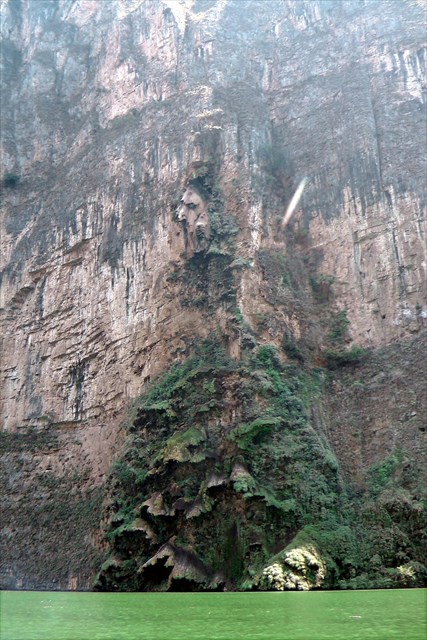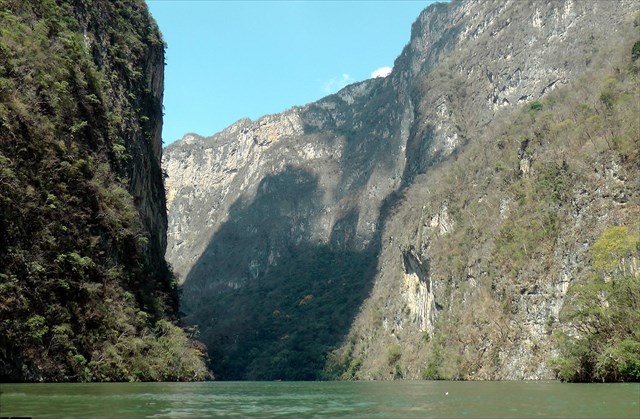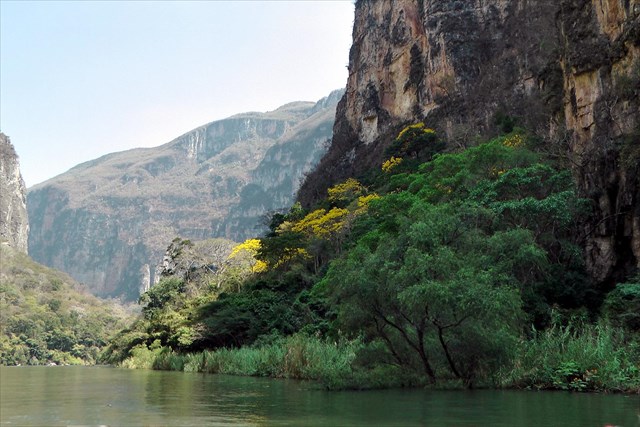Please note:
You do not need wait for our log permission but send the answer Email immediately together with the log! No logs like: "Will send the answers later, when back home, when having better internet", etc. Such kind of logs we will delete without prior notification.
Ihr müsst nicht auf unsere Logfreigabe warten, sondern könnt sofort loggen. Aber sendet die Antwortmail direkt zusammen mit dem Log! Bitte keine Logs wie "Ich sende die Antworten später, wenn ich zu Hause bin, wenn ich besseres Internet habe" usw. Solche Logs werden wir künftig ohne Rückfrage löschen, denn wir mussten bisher in solchen Fällen fast immer selbst nachfragen.

La caché sólo es posible con un barco. Los paseos en barco están disponibles a nivel local y un barco del grupo cuesta 190 MXN (fecha de publicación), un barco privado es más caro, pero por la maravilla natural vale la pena. Probablemente ves las características geológicas del cañón y cocodrilos, monos y muchas aves también.
The cache is only accessible by boat. Boat rides are offered at the coordinates and the cost for a group boat is 190 MXN (at date of publication). A private boat is much more expensive, but the natural wonder is really worth it. Surely you'll see the geological features of the canyon and most likely free-living crocodiles, monkeys and many birds.
Der Cache ist nur vom Boot aus machbar. Die Bootsfahrten werden vor Ort angeboten und es kostet mit dem Gruppenboot 190 MXN (Zeitpunkt der Veröffentlichung), Privatboot ist wesentlich teurer, aber das Naturwunder ist es wirklich wert. Ganz sicher siehst du die geologischen Besonderheiten des Canons und sehr wahrscheinlich auch freilebende Krokodile, Affen und viele Vögel.

The “Christmas Tree” in the Sumidero Canyon
About 35 million years ago the formation of the Sumidero Canyon began - incidentally at the same time as the Grand Canyon in the USA. Canyon is also the technical term for this special shape of the valley.
The Grijalva - also the main water artery of this region - mainly formed with the many brooks beside it in millions of years resulting in the unique geological formations at the banks of the river. In this way, some caves and karst, or limestone formations were formed.
Two of them are the basis of our EarthCache.
The first formation that we want to consider here is the "Chapel of Colors". The cave was formed by weathering. This refers to various forms of natural decomposition of rocks. It differs in chemical, physical and biotic weathering. These in turn have multiple subtypes.
A special subtype of the chemical weathering is the carbonic acid weathering of limestone. Water (H2O) combines with carbon dioxide (CO2) from the air and forms weakly carbonic acid (H2CO3), which can dissolve the carbonates of the limestone. The action of carbonic acid leads well below the land surface by water movement lead away or leach of carbonate rocks and thus to the formation of caves and cave systems in limestone. By evaporation or heating of the solution the carbon dioxide escapes again. This displacement is again forming insoluble limestone, which occurs in diverse forms.
This cave got its name from the additional filtration of various elements in the rocks during the weathering process, which created the cave. Water seeping through the limestone also washed them out and characteristic residues are deposited along the ceiling of the cave after the evaporation of the water. Thus the elements leave their own very specific colored residues.
The second formation is the "Christmas tree" in the Sumidero Canyon. Again, one can observe the work of the falling water. Because of the above described processes during millions of years the water masses created the typical form, which resembles a Christmas tree. The individual floors arose from the deposits entrained by the water and layered level by level to the typical compartments of this tree of stone.
Please answer the following questions:
1. In the "Chapel of Colors" you can recognize (on the basis of the colors) which minerals, mineral compounds or elements were washed out.
Use the following table to determine:
Green: Agate, hemimorphit
Black: Chromite, magnetite
Pink: Magnesium, potassium
Gold: Pyrite, millerite
Gray: Antimonite, galenite
Tell us the elements.
2. Estimate the height of the apex point of the cave above the water level.
3. The compartments of the "Christmas Tree" have a typical surface which has been formed as a result over millions of years.
Describe this surface!
Send us the answers by Email and upload a photo of you in the canyon please (not a requirement, but would be very nice). Please do not use images and logs, which are revealing the answers. We'll delete them. You can log immediately. If there is something wrong, we will contact you.

El "árbol de Navidad" en el Cañón del Sumidero
Hace aproximadamente 35 millones años empezó el proceso de la formación del Cañón Sumidero – por lo demás al mismo tiempo como el Gran Cañón en los EE.UU. Cañón es el término técnico para esa forma especial de valles.
Durante milliones de años el Grijalva, que también es la arteria principal de agua de la región, formó las formaciones geológicas únicas en las orillas del cañón. Eso se realizaba sobre todo por muchas corrientes que fluyen hacia el Grijalva a él. Así se formaron las cuevas y formaciones de carst o de piedra caliza.
Dos de ellos forman nuestro “Cache de la Tierra”.
La primera formación es la "Capilla de los Colores", constando de diversas formas de la descomposición natural de rocas, que se formó por erosion. Hay desagregación químico, físico y biótico con múltiples subtipos de cada uno.
Un subtipo de la meteorización química es la erosión del ácido carbónico de la piedra caliza. El agua (H2O) se mezcla con dióxido de carbono (CO2) del aire y forma ácido carbónico poco ácido (H2CO3), que puede resolver los carbonatos de la piedra caliza. La influencia del ácido carbónico causa un deslizamiento o un derrubio de rocas carbonatadas por el movimiento del agua muy debajo de la superficie de la tierra y forma así las cuevas y las sistemas de cuevas de piedra caliza. Por evaporación o calentamiento de la solución el dióxido de carbono escapa de nuevo. Este desplazamiento de nuevo forma piedra caliza insoluble, que existe en formas variados.
Esta cueva tiene su nombre de la filtración adicional de varios elementos en las rocas durante el proceso de la desagregación, que llevó a la formación de la cueva. El agua que se rezuma por la piedra caliza derrubiala y se la deposita en el techo de la cueva por la evaporación del agua. Así los elementos dejan cada uno su propio residuo de color los residuos característico y muy típico.
La segunda formación en el Cañon Sumidero es el "árbol de Navidad". Aquí tambien se puede ver la obra del agua cayendo. Las masas de agua formaron por los procesos describitos anteriormente durante millones de años esa forma típica, que recuerda a un árbol de Navidad. Las diferentes capas se formaron por los sedimentos que el agua llevó consigo y que era apilado poco a poco a esas formas de abanico típicas parecido a un árbol de piedra.
Por favor, contesta las siguientes preguntas:
1. En la “Capilla de los colores” puedes reconocer los minerales, compuestos minerales o elementos erosionados mediante los colores.
Para la determinación usa la tabla siguiente:
Verde: ágata, hemimorphite
Negro: cromita, magnetita
Rosa: magnesio, potasio
Oro: pirita, millerite
Gris: estibina, galena
¡Denominanos los elementos!
2. ¿Estima la altura del vértice de la cueva encima del nivel de agua?
3. Los abanicos del "árbol de Navidad" tienen una superficie típica, que se ha formado como resultado de un génisis de millones de años.
¡Describe su superficie!
Envíanos las respuestas por correo y sube una foto de tí en el cañón (opcional) - por favor solo imágenes o registros que no revelan las respuestas. Estos vamos a eliminarlo. Puedes anotar inmediatamente. Si algo este incorrecto respondaremos.

Der “Weihnachtsbaum” im Sumidero-Canyon
Vor etwa 35 Mio Jahren begann der Prozess der Entstehung des Sumidero Canyon - übrigens zur gleichen Zeit wie auch der Grand Canyon in den USA. Canyon ist auch der fachliche Begriff für diese spezielle Talform.
Der Grijalva welcher auch die Hauptwasserader dieser Region darstellt, formte vor allem mit den vielen auf ihn zufließenden Bächen über Jahrmillionen hinweg die einzigartigen geologischen Formationen an den Ufern des Canyons. So bildeten sich Höhlen und Karst- oder Kalksteinformationen.
Zwei von ihnen bilden unseren Earth-Cache.
Die erste Formation, um die es hier geht, ist die" Kapelle der Farben". Die Höhle entstand durch Verwitterung. Darunter versteht man verschiedene Formen der natürlichen Zersetzung von Gestein. Man unterscheidet in chemische, physikalische und biotische Verwitterung. Diese besitzen wiederum mehrere Unterarten.
Eine Unterart der der chemischen Verwitterung ist die Kohlensäureverwitterung von Kalkstein. Es verbindet sich das Wasser (H2O) mit Kohlenstoffdioxid (CO2) aus der Luft und bildet schwach saure Kohlensäure (H2CO3), welche die Carbonate des Kalksteins lösen kann. Die Einwirkung der Kohlensäure führt auch noch tief unter der Landoberfläche durch Wasserbewegung zur Wegführung oder Auswaschung von Carbonatgestein und damit zur Bildung von Höhlen und Höhlensystemen im Kalkgestein. Durch Verdunstung oder Erhitzen der Lösung entweicht das Kohlendioxid wieder. Durch diese Verschiebung bildet sich wieder unlöslicher Kalkstein, welcher in vielfältigsten Formen vorkommt.
Diese Höhle hat ihren Namen von der zusätzlichen Filtration verschiedener Elemente im Gestein während des Verwitterungsprozesses, der die Höhle entstehen ließ. Die durch das Kalkgestein sickernden Gewässer waschen auch diese aus und an der Decke der Höhle setzen sich die charakteristischen Rückstände durch die Verdunstung des Wassers ab. Dabei hinterlassen Elemente jeweils ihre eigenen, ganz typischen Farbrückstände.
Die zweite Formation ist der "Weihnachtsbaum" im Sumidero Canyon. Auch hier ist die Arbeit des herabstürzenden Wassers zu beobachten. Über Jahrmillionen hinweg formten die Wassermassen durch die oben beschriebenen Prozesse die typische Form, welche an einen Weihnachtsbaum erinnert. Die einzelnen Etagen entstanden aus den vom Wasser mitgeführten Ablagerungen und schichteten sich Ebene um Ebene zu den typischen Fächern dieses steinernen Baumes auf.
Beantworte bitte folgende Fragen:
1. In der "Kapelle der Farben" erkennst du anhand der Farben, welche Minerale, mineralischen Verbindungen oder Elemente ausgewaschen wurden.
Nutze zur Bestimmung folgende Tabelle:
Grün: Achat , Hemimorphit
Schwarz: Chromit, Magnetit
Rosa: Magnesium, Kalium
Gold: Pyrit, Millerit
Grau: Antimonit, Galenit
Nenne uns die Elemente!
2. Schätze die Höhe des Scheitelpunktes der Höhle über dem Wasserspiegel!
3. Die Fächer des "Weihnachtsbaumes" haben eine typische Oberfläche, welche sich im Ergebnis der jahrmillionen langen Entstehungsgeschichte gebildet hat.
Beschreibe diese Oberfläche!
Sendet uns die Antworten per Email und ladet bitte ein Bild von Euch im Canyon mit hoch (keine Bedingung). Bitte keine Bilder und Logs, die die Antworten verraten. Diese werden wir löschen. Ihr könnt sofort loggen. Wenn etwas nicht stimmen sollte, melden wir uns.
